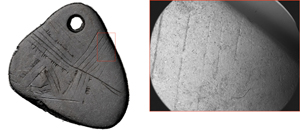
Recent microwear research carried out on Mesolithic ornaments, mostly from burial contexts, has shown that this method can reveal significant information regarding an ornament's manufacture and function (Cristiani et al. 2014a; 2014b; Larsson 2006; Rigaud et al. 2015). With this in mind microwear analysis was carried out on the pendant. Using a low power stereoscope at magnifications x10-x100, followed by high power analysis with a Leica DM1750M reflected light microscope at magnifications ranging from x10-x50, with eyepiece magnifications at x16, the entire surface of the pendant was analysed for wear traces.
Analysis was made difficult by the amount of highly reflective inclusions of what appeared to be iron pyrite (see residue section) and post-depositional surface modification (PDSM) which has resulted in the entire surface displaying a sheen or 'brightness'. This brightness is caused by two factors: reflective pyrite inclusions and a general abrasion to the surface caused by the soft shale pendant sitting in mud and water for 11,000 years.
The slightly more worn areas of the engraving mentioned in section 4.2 phase 3 (Figure 17) display no wear polish that can be attributed to anthropogenic activity; microscopically, there is no distinction on the surface of the pendant at these locations from any other part of the surface. One explanation is that they may, due to their higher topography, have become more affected and worn through time due to natural processes.

No discernible evidence for wear traces relating to suspension could be found from within or around the perforation. However, it remains possible that the pendant was suspended and worn, but for such a limited duration of time as to leave no traces. Indeed, it is also possible that it was intended for a single use, such as a ceremony, which is unlikely to leave any signatures of use at all. The adjacent edge of the nearest vertex did, however, display a slightly brighter sheen compared to the other edges. This is also the location where polish emanating from wear would be expected if the pendant was suspended with the perforation at the top and the long axis of the triangle at the bottom. This may indicate that it was in fact suspended and worn as a pendant but as this location is just a slightly brighter area and cannot be characterised as polish per se (Vaughan 1985), and displays no clear directionality, striations or rounding, and given that the entire surface of the pendant has a sheen, such an interpretation comes with a strong caveat.